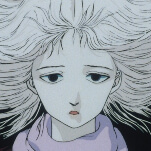Roy and Inaki Miranda’s sci-fi apocalypse book has only released two issues thus far, but it definitely feels like that’s the only song they know how to play. It’s maybe best exemplified in the second issue, when a supporting character promises things will be fine the instant before he’s devoured by a mutant lion. It’s unintentionally hilarious in how sudden it is, but the book doesn’t stop there. More of those lions show up, and everyone who wasn’t named gets torn to shreds for no other reason than needing to make our lead characters’ journey much harder. Not that it wasn’t hard enough already: We Live is set on an Earth on the brink of destruction, with only five thousand children promised to be taken off-world to presumed safety—provided they can reach a beacon in time. So Hototo and Tala, plus their new friend Humbo and his guardian ape, Alice, set out to make the trek to salvation on foot (after escaping that lion massacre, of course).
Apocalypse stories are only as interesting as their characters, and right now, Humbo and Alice are the better pair compared to Tala and Hototo. The former pair feel much more like real beings, whereas the siblings are just passive vessels, letting things happen to them. There’s a real tension to their dynamic, as Humbo tries to deal with the emotional fallout from leaving his former guardian to certain death, which the book seems comfortable exploring without immediately flipping to shock-value violence. And the moments of childlike fun with Humbo come across as much more authentic, such as when he acquires an old mech and accidentally blasts into the sky. And that’s because they involve him living in the world—he isn’t trying to ignore the horrors around him like his less-interesting companions.
Beyond Humbo and Alice, what makes the book worth sticking with are its mutated creatures. Silly as it may sound to simply give each animal extra eyes and additional colors, Inaki Miranda makes it work. It’s just enough to make them look alien without also being completely unfamiliar. Colorist Eva de la Cruz makes the world look striking and vivid—which on some level is narratively necessary, since Humbo can only communicate with Alice via color, as demonstrated in a touching flashback during the book’s second issue. The pieces for We Live to come together into something stronger are all there. What’s on the page thus far is enjoyable enough, but it’s clear that it has the potential to bloom into something more interesting—or at least more fun—later on.









































